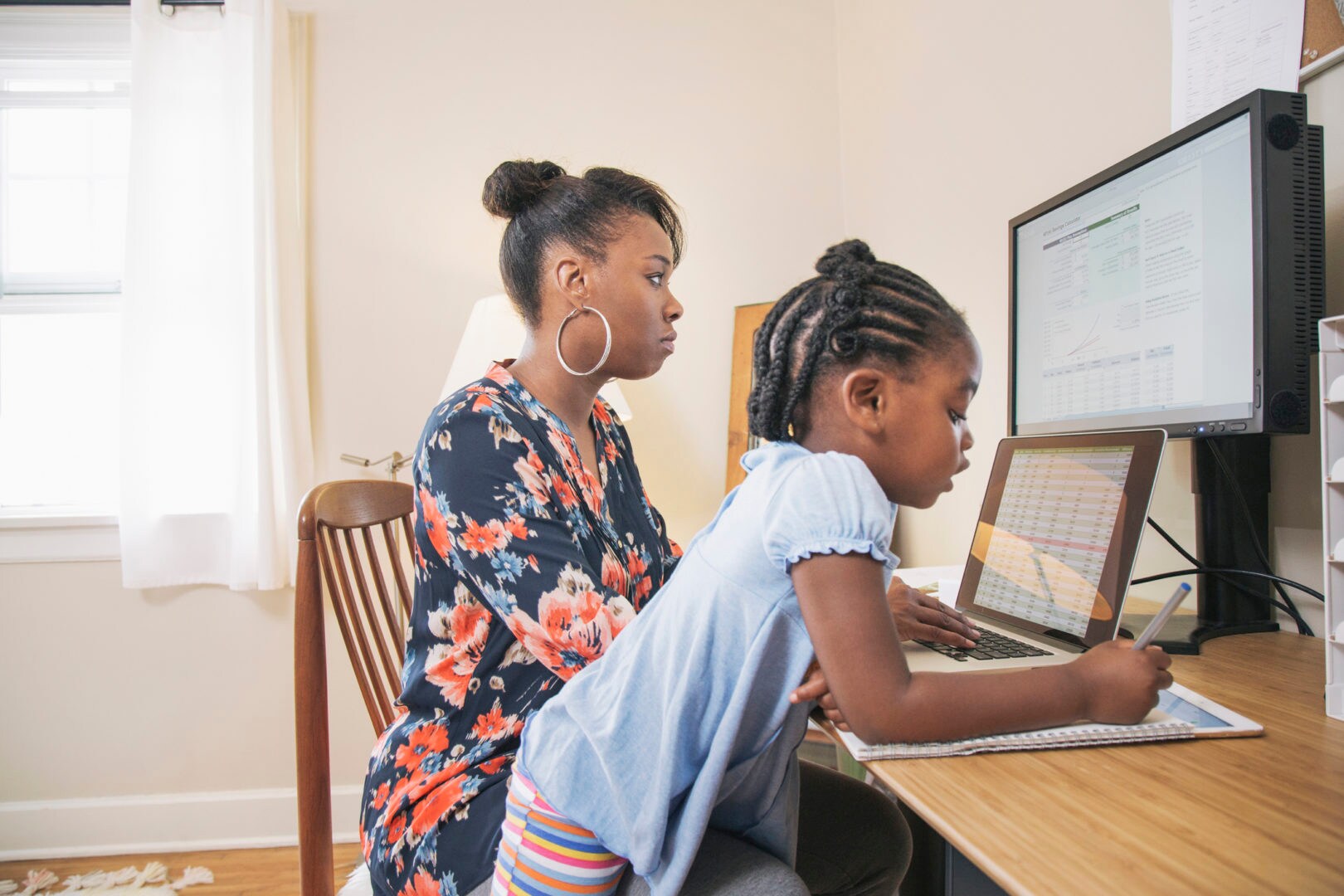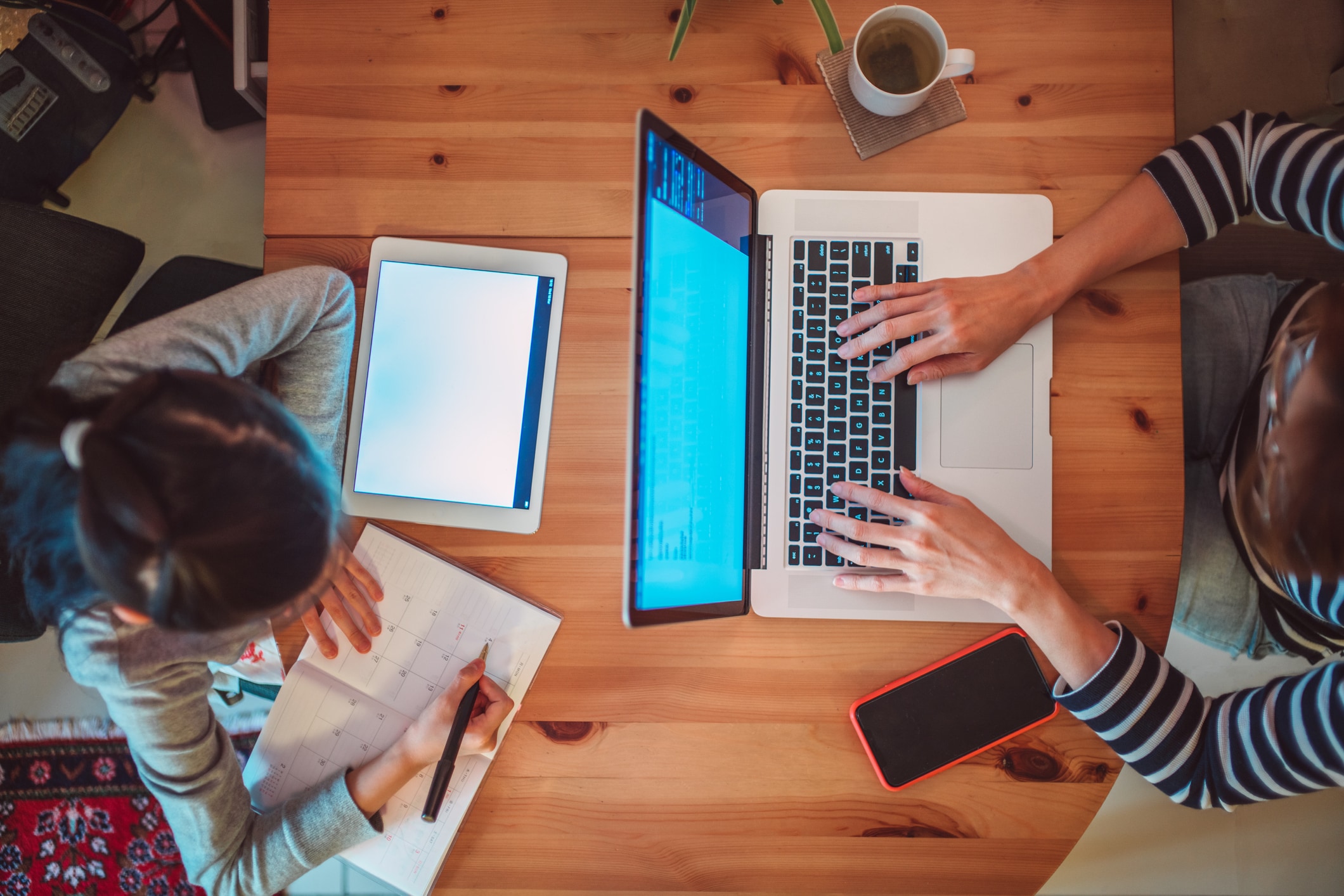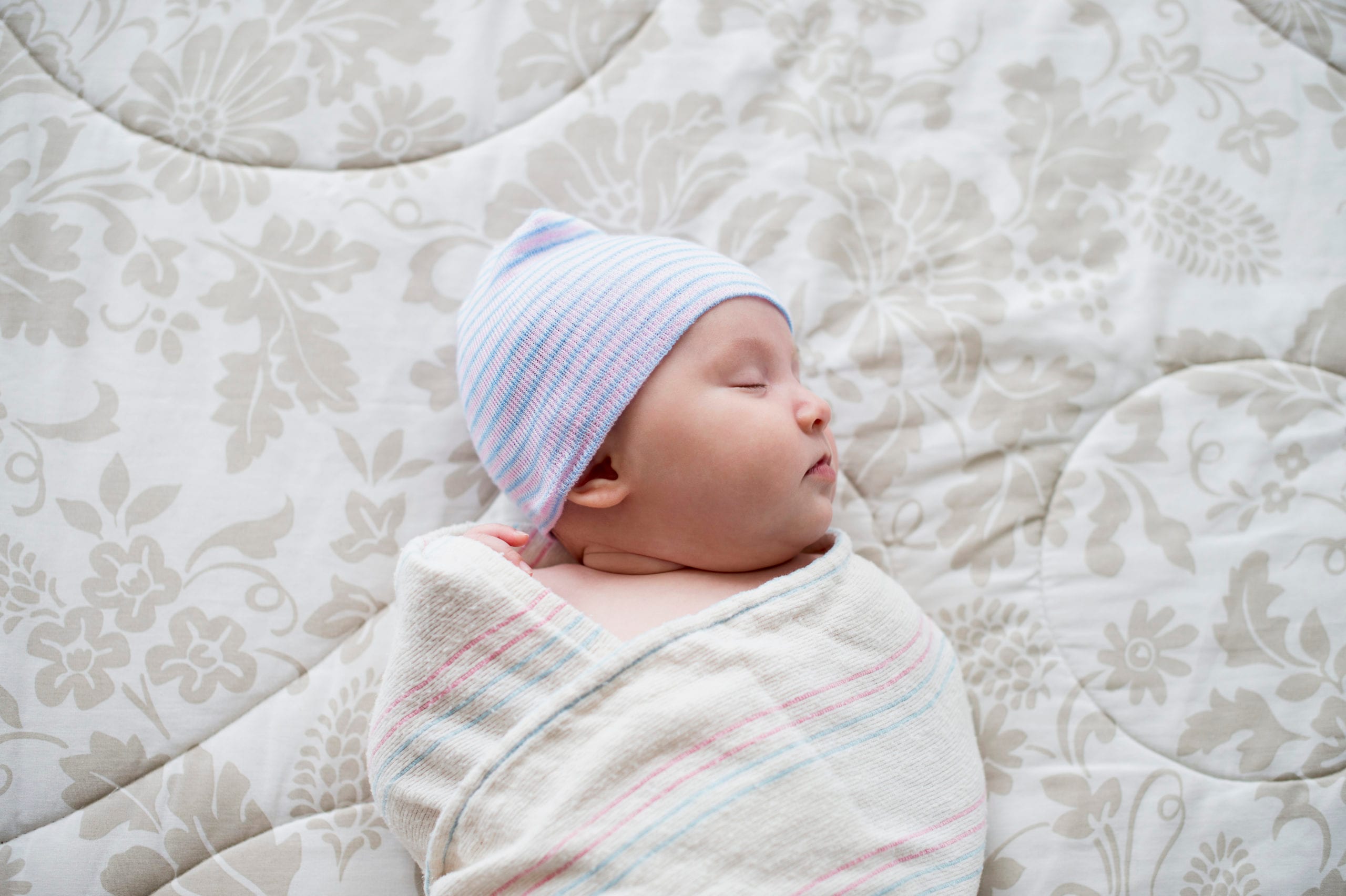Ashley Howard of White Plains, New York has three kids, ages 2, 3 and 6. She works in account management for a tech company. Before COVID, her child care was covered through day care, camps and a nanny. Now? “It’s a daily juggling act with no consistency since each respective school will often, without notice, change whether they are in-person.” At times the school has closed in-person learning for a two-week period.
Howard says it’s terrible for all parties. She can’t get her kids on a consistent schedule because of the frequent school disruptions. And with three children at home, her job performance is suffering as well. “Remote learning makes it impossible to focus on work and manage your career requirements.” Plan for time off? Forget it. She’s already used up most of her PTO.
What would help? One word: consistency.
If you’re a parent, this may sound familiar to you. For the past year (yes, it’s been a whole year now), parents have been scrambling and improvising as so many jobs become remote-from-home, schools close to in-person classes and child care options dwindle. It’s been a seismic shift for most of us. How are we coping? We went behind the forced smiles and “fine, everything’s fine!” and asked some parents to tell us how it’s going. Like, really. How are you managing, and what kind of toll has this taken on you, your kids and your relationships?
Bring back flexibility: Single, steady child care would help
Ariel Beechum could use some consistency as well, in the form of regular child care. But even more than that, she needs more flexibility. She’s raising her 5-year-old son mostly on her own in White Plains, New York. A hospital social worker, she’s been able to transfer her job to a facility located closer to home. Meanwhile, the local schools have been doing hybrid learning: in-class instruction in smaller groups a couple days a week and remote learning at home the rest of the week. When her son isn’t attending in-person kindergarten, different family members help out with child care on an ad hoc basis.
Beechum separated from her son’s father in October 2020. She says the pressures of balancing remote learning and parenting while working from home caused tension that led to their separation. “Since our separation, it has been difficult finding child care for our son,” she explains. It’s available at the local YWCA, but COVID-era transportation logistics place it out of reach.
Her son is restricted to the same school bus route, with the same pod of children, every time, in order to reduce the risk of the virus spreading. He’s not allowed to take a different bus after school to child care or to his father’s home because that would mean exposure to a different set of children than those in his usual neighborhood bus pod. And so, Beechum is relying on a different family member to help out on a day-to-day basis. She would love a single, steady child care solution for remote days and after school. But greater flexibility with school busing would help as well.
Send help: “I’m too exhausted to parent”
Tiffany Geard is a freelance photographer, and she was working all over New York City when the pandemic hit. As the mother of a 3 1/2-year-old son, she’s now working closer to home north of the city in Hastings-on-Hudson, doing mostly products, remote shoots and socially-distanced portraits. She used to rely on preschool and babysitters for child care, but now has neither. “We homeschool now,” she says.
And she’s exhausted. “I’m too exhausted to parent, to enjoy time along with the hubs … exhausted.” She worries about money, life and death and being able to “keep a big smile on for my kid.” In fact, two things she could really use right now are money and a teacher. “There’s a reason why not all of us are teachers,” she says. Homeschooling has made her aware of the very specific skills and energy that profession requires. And like so many other parents, Geard feels like she and her family need more structure in their lives.
Amy Christensen’s family knows that exhaustion, too. Before COVID, Christensen spent a lot of her time surrounded by plants. She works in professional plant care, a passion of hers, during the day. Her husband owns a restaurant and works evenings. Since COVID, Christensen has cut her working hours in half. Now she works in the morning while her husband homeschools their 8-year-old twins. She gets home at 2 p.m. to “take over whatever’s left” while he leaves for work.
It’s exhausting, especially for her husband, who works late into the night and then rises early to start school at 8 a.m. “My kids are stressed out and not learning properly,” Christensen adds. Her son, who struggles with social and emotional development, has an IEP (Individualized Education Program). But that’s hard to pull off without the structure of in-person school. “Missing school and specifically peer interaction has really set him back,” she says. Being back in the classroom full time would be ideal, but at this point, tutoring would help a lot.
Oh, the monotony: “I just keep charging on”
Even if you’ve got consistency nailed down, if your new COVID life is radically different from your “before times” life, that can be its own particular kind of stress. Prior to the pandemic, New York City independent publicist Sarina Appel was active with event production, client lunches and meetings, business travel and networking. Now she’s fitting in work while managing remote learning for her two children, ages 8 and 10.
She’s on her game. Appel rearranged the playroom to create a home classroom with two desks, computers, headphones and lamps for each. They even have filing cabinets to store schoolwork. “I maintain their schedules and drop everything to help my 8-year-old complete her work during the day,” she says. Unofficially, she also fills in as an unpaid teacher’s assistant. The school day ends by 2 p.m. when she “drags” her kids to the park — not fun in the winter, but necessary. She brings them back by 4:30 so she can begin preparing dinner.
All of this supervision allows Appel’s husband to stay in his “office” (a dedicated corner of their bedroom) the entire day. But the routine is wearing on her. “I often get frustrated with the monotony,” she admits. Nevertheless, she says, “I just keep charging on and let my husband work.” She would love it if in-person school could resume full time.
Give me a break: “I just need some alone time”
Amy Chin, also a New Yorker, was launching a new business when the pandemic started, and she’s had to reduce her hours. Her 5- and 8-year-old were remote learning until recently. Her kindergartener was finally able to return to in-person learning in December, but that hasn’t made life any easier; it only swapped one set of issues for another. Chin’s younger daughter lost important ground with remote learning and is struggling. “Now she’s so far behind, the school may have her repeat the year.”
Chin feels “like a mad woman.” She’s getting less sleep, and she’s sick of cooking. “It sucks,” she says. “I’m tired and have not had five minutes to spare.” She sees the impact on her children as well. In addition to her youngest falling behind, there’s all the screentime. “I see my 8-year-old blinking from all the screen usage,” she reports, and she worries that they’re regressing socially.
Also? “I hate my partner,” Chin admits. “I just need some alone time.” What would help her the most is someone to care for her children so she could have a day off.
Save teen parents: “It feels like I’m walking on eggshells,”
You would think having older children in “pandemic times” would be easier, but that’s not necessarily the case for everyone. Nandita Godbole of Atlanta is the mother of a very stressed-out 17-year-old daughter. It’s been reported widely that the isolation of the past year has hit teenagers and young adults hardest of all.
Godbole is a freelance food writer accustomed to six to eight hours of uninterrupted time for work. “Now, I can barely manage three to four a day, and some days not even that much,” she says. With fewer working hours, she has less time to pursue freelancing gigs and writing.
The county is providing free lunches for students, but her daughter prefers the comfort of her mother’s home cooking. “I have to concoct new and exciting lunches every day,” Godbole jokes. But the more serious burden is the emotional impact of social isolation on her daughter. “My teen craves socializing with her fellow introvert friends, so I have to be available whenever she is bored so she does not end up in front of yet another screen.” Godbole feels like she’s always on edge, ever vigilant of her teen’s mood swings. “It feels like I’m walking on eggshells,” she says.
They try to do a few activities together, but then it’s back to the screen. To decompress from school, Godbole’s daughter has been working on her digital arts skills. She’s proud of her daughter’s creative output and appreciates its therapeutic value for her daughter. But she’s still carrying a lot of anxiety herself. Leaving the house doesn’t help since so many of the people in her community go maskless. “Even our short and quick errands are stressful,” she says. She would love it if everyone would just wear a mask.
Make work more flexible: It’s still hard but better
For Carissa Bautista of Salt Lake City, the changes that have come with the pandemic haven’t all been negative. Since her job as an eligibility specialist at Housing Authority is considered essential, she has continued working full time. But her employer has been very flexible with her, and she works from home two days a week. Her ex-husband is also an essential worker, but he has the flexibility to work from home as well. So they’ve been able to share caring for their two children without too much trouble.
On the other hand, Bautista says, “distance learning has been a bit difficult.” Her 8-year-old daughter can work independently and is doing well academically. She misses her friends, though. Before the pandemic, she and her 6-year-old brother attended an after-school program and a summer program.
Bautista’s son is struggling much more. He is on the spectrum and needs extra help with his distance learning, which makes focusing on work difficult. His biggest challenge is staying on task. “He would likely do better with in-person learning,” says Bautista, “but I am not ready to send them back yet.”
Aside from the stress of distance learning, Bautista appreciates how much more time she’s been spending with her kids. “Before COVID, I was constantly busy running back and forth between school and work. The evenings went by too quickly,” she says. That lifestyle didn’t give her a lot of quality time with her young family. The surprise benefit of the past year, on the other hand, has been feeling closer to her kids.
Set parents up for success: I want to give my kids my best possible self
A. Rochaun Meadows-Fernandez is another parent who’s been lucky enough to transition smoothly and even find a few blessings in the past year. She was already used to juggling her work as a freelance writer with caring for her 2-year-old daughter. Her now 5-year-old son had been in day care for a few months pre-pandemic. But when COVID restrictions were put in place there and kids started passing around colds, Meadows-Fernandez decided to keep him home as well.
“For the most part, there’s been minimal difference in our life during the pandemic,” Meadows-Fernandez says. The biggest change was starting graduate school. She just started a masters program in American Studies, focused on Black women’s reproductive experiences. In fact, it was the pandemic that made school accessible to her because it’s virtual. “It’s been wonderful for me because with two small kids, I wouldn’t have had the ability to go to school otherwise,” she says.
It’s a more complex juggle, to be sure, but one that feels familiar. And Meadows-Fernandez set her intentions early in the pandemic. “I was just like, ‘I’m not about to stress myself the hell out like I usually do.” So she scaled back on her freelance writing work in order to prioritize school, and she hired the 15-year-old daughter of a friend to watch her children three to four hours a day. This gives her time to focus on work and “make sure that I’m not just giving my children the worst possible version of myself.”
And yes, Meadows-Fernandez adds, “I know there’s a level of privilege in that because my husband is the anchor income person.” He also works long hours for the military, mostly outside the home. She wouldn’t mind it if there were some way he could work from home more often.
Change parenting expectations for good: Let’s never go back
Looking ahead, Meadows-Fernandez hopes that once the pandemic is over, “people aren’t going to return to these ridiculous expectations that we can do everything and be everything.” She also hopes that the work accommodations for parents, while admittedly inadequate, remain in place because “we’re not just parenting through a pandemic, we’re parenting always.”





